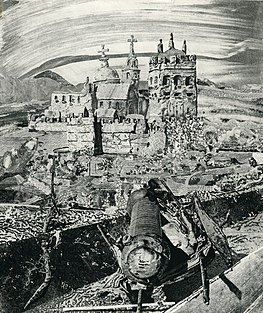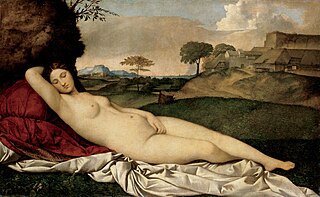 W
WThe Battle of Delebio was a battle of the Wars in Lombardy. It occurred on 18 and 19 November 1432, near Delebio, in the Valtellina. It was an aftermath of the occupation of Brescia and the Valle Camonica by the armies of the Republic of Venice, led by Francesco Bussone, Count of Carmagnola.
 W
WThe Battle of Fornovo took place 30 km southwest of the city of Parma on 6 July 1495. It was fought as King Charles VIII of France left Naples upon hearing the news of the grand coalition assembled against him. Despite the numerical advantage of their opponents, the French managed to pass through. It was nonetheless devoid of any strategic result as all of their conquests in the Italian Peninsula were abandoned. Fornovo was the first major pitched battle of the Italian Wars.
 W
WThe Battle of Riccardina or Battle of Molinella, fought on July 25, 1467, in Molinella, was one of the most important battles of the 15th century in Italy.
 W
WThe Battle on the Po was a battle of the Wars in Lombardy. It occurred in June 1431, on the Po River, near Cremona. The battle was fought between 85 Venetian galleys, sent towards Cremona to support Count of Carmagnola's army, and a somewhat superior number of Milanese galleys. The Venetians were commanded by Niccolò Trevisani.
 W
WGaleas per montes is the name by which an enterprise of military engineering made between December 1438 and April 1439 by the Republic of Venice and consisting of the transport of ships, Galleys and frigates from the Adriatic Sea to Lake Garda, climbing the river Adige to Rovereto and transporting ships by land to Torbole, on the northern shores of the lake. A journey of about 20 km through the mountains and the Loppio Lake, now almost disappeared following the construction of the Galleria Adige-Garda, which emptied the lake above.
 W
WThe First Italian War, sometimes referred to as the Italian War of 1494 or Charles VIII's Italian War, was the opening phase of the Italian Wars. The war pitted Charles VIII of France, who had initial Milanese aid, against the Holy Roman Empire, Spain, and an alliance of Italian powers led by Pope Alexander VI.
 W
WThe Second Italian War (1499–1504), sometimes known as Louis XII's Italian War or the War over Naples, was the second of the Italian Wars; it was fought primarily by Louis XII of France and Ferdinand II of Aragon, with the participation of several Italian powers. In the aftermath of the First Italian War, Louis was determined to press his claim on the thrones of Milan and Naples. And in 1499, Louis XII invaded Lombardy and seized Milan, to which he had a claim in right of his paternal grandmother Valentina Visconti, Duchess of Orléans.
 W
WThe Italic League or Most Holy League was an international agreement concluded in Venice on 30 August 1454, between the Papal States, the Republic of Venice, the Duchy of Milan, the Republic of Florence and the Kingdom of Naples, following the Treaty of Lodi a few months previously.
 W
WThe Wars in Lombardy were a series of conflicts between the Republic of Venice and the Duchy of Milan and their respective allies, fought in four campaigns in a struggle for hegemony in Northern Italy that ravaged the economy of Lombardy and weakened the power of Venice. They lasted from 1423 until the signing of the Treaty of Lodi in 1454. During their course, the political structure of Italy was transformed: out of a competitive congeries of communes and city-states emerged the five major Italian territorial powers that would make up the map of Italy for the remainder of the 15th century and the beginning of the Italian Wars at the turn of the 16th century. They were Venice, Milan, Florence, the Papal States and Naples. Important cultural centers of Tuscany and Northern Italy—Siena, Pisa, Urbino, Mantua, Ferrara—became politically marginalized.
 W
WThe Ottoman–Venetian peace treaty of 1419 was signed between the Ottoman Empire and Republic of Venice, ending a short conflict between the two powers, confirming Venetian possessions in the Aegean Sea and the Balkans, and stipulating the rules of maritime trade between them.
 W
WThe First Ottoman–Venetian War was fought between the Republic of Venice and her allies and the Ottoman Empire from 1463 to 1479. Fought shortly after the capture of Constantinople and the remnants of the Byzantine Empire by the Ottomans, it resulted in the loss of several Venetian holdings in Albania and Greece, most importantly the island of Negroponte (Euboea), which had been a Venetian protectorate for centuries. The war also saw the rapid expansion of the Ottoman navy, which became able to challenge the Venetians and the Knights Hospitaller for supremacy in the Aegean Sea. In the closing years of the war, however, the Republic managed to recoup its losses by the de facto acquisition of the Crusader Kingdom of Cyprus.
 W
WThe siege of Thessalonica between 1422 and 1430 saw the Ottoman Empire under Sultan Murad II capture the city of Thessalonica, which remained in Ottoman hands for the next five centuries, until it became part of the Kingdom of Greece in 1912.
 W
WThe Venetian Renaissance had a distinct character compared to the general Italian Renaissance elsewhere. The Republic of Venice was topographically distinct from the rest of the city-states of Renaissance Italy as a result of their geographic location which isolated the city politically, economically and culturally allowing the city the leisure to pursue the pleasures of art. The influence of Venetian art did not cease to continue at the termination of the Renaissance period. Its practices persisted through the works of art critics and artists proliferating its prominence around Europe to the 19th century.
 W
WVenetian Renaissance architecture began rather later than in Florence, not really before the 1480s, and throughout the period mostly relied on architects imported from elsewhere in Italy. The city was very rich during the period, and prone to fires, so there was a large amount of building going on most of the time, and at least the facades of Venetian buildings were often particularly luxuriantly ornamented.
 W
WVenetian painting was a major force in Italian Renaissance painting and beyond. Beginning with the work of Giovanni Bellini and his brother Gentile Bellini and their workshops, the major artists of the Venetian school included Giorgione, Titian, Tintoretto (1518–1594), Paolo Veronese (1528–1588) and Jacopo Bassano (1510–1592) and his sons. Considered to give primacy of colour over line, the tradition of the Venetian school contrasted with the Mannerism prevalent in the rest of Italy. The Venetian style exerted great influence upon the subsequent development of Western painting.